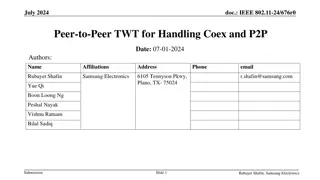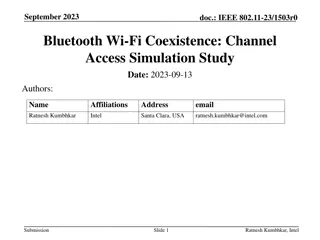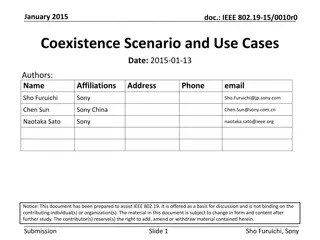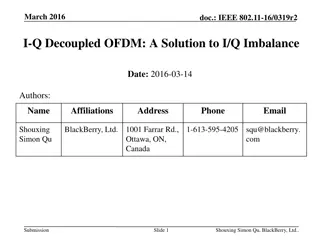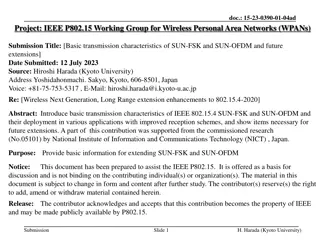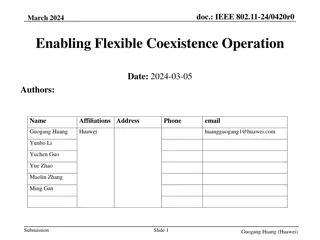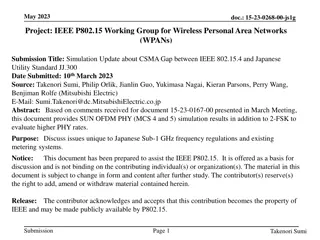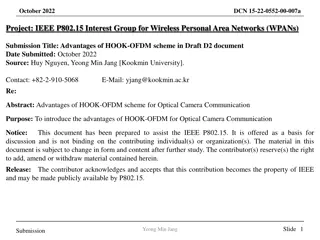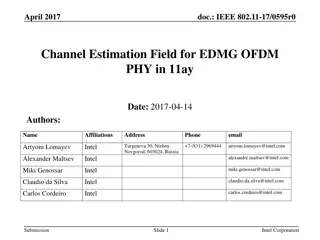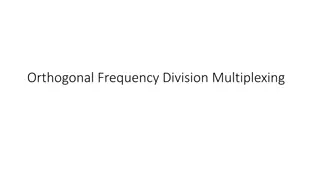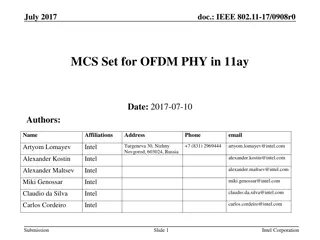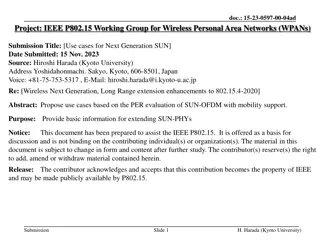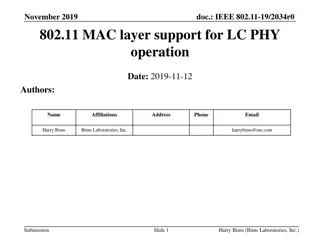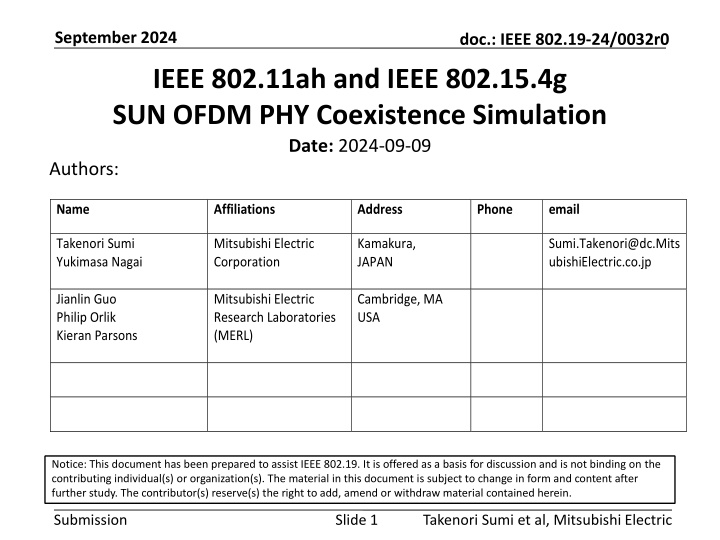
IEEE 802.19-24 Simulation Update for Coexistence of IEEE 802.15.4g and IEEE 802.11ah
Explore the simulation update for the coexistence of IEEE 802.15.4g and IEEE 802.11ah in the September 2024 document. The study focuses on smart utility use cases, presenting simulation parameters, performance metrics, and the background of the study. Dive into the details of simulation models, deployment discussions, and simulation results shared for evaluation. Gain insights into the specified simulation parameters, node numbers, offered loads, packet sizes, data rates, packet delivery rates, propagation models, and more, all detailed in the documentation for IEEE 802.19-24.
Download Presentation

Please find below an Image/Link to download the presentation.
The content on the website is provided AS IS for your information and personal use only. It may not be sold, licensed, or shared on other websites without obtaining consent from the author. If you encounter any issues during the download, it is possible that the publisher has removed the file from their server.
You are allowed to download the files provided on this website for personal or commercial use, subject to the condition that they are used lawfully. All files are the property of their respective owners.
The content on the website is provided AS IS for your information and personal use only. It may not be sold, licensed, or shared on other websites without obtaining consent from the author.
E N D
Presentation Transcript
September 2024 doc.: IEEE 802.19-24/0032r0 IEEE 802.11ah and IEEE 802.15.4g SUN OFDM PHY Coexistence Simulation Date: 2024-09-09 Authors: Name Affiliations Address Phone email Takenori Sumi Yukimasa Nagai Jianlin Guo Philip Orlik Kieran Parsons Mitsubishi Electric Corporation Kamakura, JAPAN Sumi.Takenori@dc.Mits ubishiElectric.co.jp Mitsubishi Electric Research Laboratories (MERL) Cambridge, MA USA Notice: This document has been prepared to assist IEEE 802.19. It is offered as a basis for discussion and is not binding on the contributing individual(s) or organization(s). The material in this document is subject to change in form and content after further study. The contributor(s) reserve(s) the right to add, amend or withdraw material contained herein. Submission Slide 1 Takenori Sumi et al, Mitsubishi Electric
September 2024 doc.: IEEE 802.19-24/0032r0 Summary Presentation to TG3a of simulation update for coexistence of IEEE 802.15.4g and IEEE 802.11ah using new simulation parameters for smart utility use cases. o Case 1: This slide (IEEE 802.15.4g-OFDM PHY and IEEE 802.11ah) o Case 2 3: Following meetings This document gathers relevant material from 19-24/0018r0, 19-19/0019r1, 19-18/0056r3, 19-18/0039r1 and 19- 19/0021r2. Submission Slide 2 Takenori Sumi et al, Mitsubishi Electric
September 2024 doc.: IEEE 802.19-24/0032r0 Background: S1G Coexistence Simulations in TG3 Developed the coexistence simulator based on NS-3.23, which support IEEE 802.15.4g-FSK (400 KHz bandwidth) and IEEE 802.11ah (1 MHz bandwidth) for IEEE 802.19.3. Extended this simulator to support IEEE 802.15.4-OFDM (400 KHz bandwidth) to evaluate IEEE 802.19.3a. Simulation parameters and simulator deployment were discussed in TG3, and simulation results were also shared. o 19-24/0018r0, 19-19/0019r1, 19-18/0056r3, 19-18/0039r1 and 19-19/0019r2 FSK PHY (200 or 400 KHz) OFDM PHY (200 or 400 KHz) OFDM PHY (1 MHz, so far) Simulation Model by NS-3 Submission Slide 3 Takenori Sumi et al, Mitsubishi Electric
September 2024 doc.: IEEE 802.19-24/0032r0 Simulation Parameters and Performance Metrics Sub-1 GHz Coexistence Simulation Parameters have been specified in doc. 19-18/0039. Some simulation parameters were updated based on the March 2024 meeting. Number of nodes o [15*, 50, 100] *500 nodes / km2 based on use case comments at IEEE 802.19.3, March 2019. Total offered load for 802.15.4g-OFDM PHY network and 802.11ah network o [20 120] kb/s for IEEE 802.11ah (1 MHz BW) o [80 480] kb/s for IEEE 802.11ah (4 MHz BW) o [10, 20, 40] kb/s for IEEE 802.15.4g-FSK PHY o [20 100] kb/s for IEEE 802.15.4g-OFDM PHY Packet size o 100 byte PHY data rate o BPSK , Nss = 1, 300 kb/s for 802.11ah (1 MHz BW) o 2FSK, 100 kb/s for 802.15.4g-FSK PHY o OFDM Option 3 MCS4, 300 kb/s, and OFDM Option 3 MCS 5, 400kb/s for IEEE 802.15.4g-OFDM PHY Data packet delivery rate o # ?? ??????? ??????????? Data packet latency o Start timer when CSMA/CA is started, stop timer when ACK is received. o ????????+ ???????+ ????????+ ?????? Propagation Model o SEAMCAT Extended Hata Model (Suburban) based on use case comments at IEEE 802.19.3, March 2019. 802.15.4: Utility pole height to node location level 802.11ah: AP/STA location level o ITU-R P.1411 NLoS (between terminals located from below roof-top height to near street level) # ?? ??????? ???????? Submission Slide 4 Takenori Sumi et al, Mitsubishi Electric
September 2024 doc.: IEEE 802.19-24/0032r0 Node Deployment : 15 nodes (500 nodes/km2)* 100 802.11ah (AP/STA) #1 80 802.11ah (AP/STA) #2 60 802.11ah (AP/STA) #3 40 802.15.4g (PANC) 802.15.4g (NODE) * 20 y[m] 0 -20 -40 -60 -80 -100 -100 -80 -60 -40 -20 0 20 40 60 80 100 x[m] Submission Slide 5 Takenori Sumi et al, Mitsubishi Electric *Same condition discussed in TG3
September 2024 doc.: IEEE 802.19-24/0032r0 Propagation Model* In consideration of device location, SEAMCAT Extended Hata Model (Suburban) was also added for simulation. Device location o 802.15.4: Utility pole height to node location level o 802.11ah: AP/STA location level SEAMCAT Extended Hata Model ITU-R P.1411 Models for propagation between terminals located from below roof-top height to near street level Submission Slide 6 Takenori Sumi et al, Mitsubishi Electric *Same condition discussed in TG3
September 2024 doc.: IEEE 802.19-24/0032r0 Propagation Model* SEAMCAT Extended Hata Model (Suburban) 802.15.4g Submission Slide 7 Takenori Sumi et al, Mitsubishi Electric *Same condition discussed in TG3
September 2024 doc.: IEEE 802.19-24/0032r0 Simulation Matrix for TG3 and TG3a 4 types of PHY combination are possible. Starting implementation in the following order. Simulation for Case 1 has done for this meeting comparing to TG3 condition. IEEE 802.11ah (1 MHz) (TG3) IEEE 802.11ah (4 MHz) IEEE 802.15.4g-FSK PHY (2) IEEE 802.15.4g-OFDM PHY (1) (3) Submission Slide 8 Takenori Sumi et al, Mitsubishi Electric
September 2024 doc.: IEEE 802.19-24/0032r0 Simulation Result (Case 1) IEEE 802.11ah (1 MHz) - IEEE 802.15.4g-OFDM PHY 802.15.4g offered load is 10 kbps 200 1 180 0.9 160 0.8 Delay (Average)[ms] 140 0.7 Delivery Rate 120 0.6 100 0.5 80 0.4 60 0.3 140 40 0.2 20 0.1 120 0 0 Delay (Average)[ms] 0 20 40 60 80 100 120 0 20 40 60 80 100 120 100 11ah Offered Load[kbps] 11ah Offered Load[kbps] 11ah (15.4g PHY:OFDM MCS5) 80 11ah (15.4g PHY:OFDM MCS4) When 802.11ah offered load is higher, only 802.15.4g delivery rate decreases, not only when FSK is used but also when OFDM is used. When 802.11ah offered load is higher than 60 kbps, 802.11ah delivery rate does not decrease, but delay increases rapidly. 0 0 20 60 11ah (15.4g PHY:2-FSK) 15.4g (15.4g PHY:OFDM MCS5) 40 15.4g (15.4g PHY:OFDM MCS4) 15.4g (15.4g PHY:2-FSK) 20 40 60 80 100 120 Submission Slide 9 11ah Offered Load[kbps] Takenori Sumi et al, Mitsubishi Electric
September 2024 doc.: IEEE 802.19-24/0032r0 Simulation Result (Case 1) IEEE 802.11ah (1 MHz) - IEEE 802.15.4g-OFDM PHY 802.15.4g offered load is 20 kbps 200 1 180 0.9 160 0.8 Delay (Average)[ms] 140 0.7 Delivery Rate 120 0.6 100 0.5 80 0.4 60 0.3 140 40 0.2 20 0.1 120 0 0 Delay (Average)[ms] 0 20 40 60 80 100 120 0 20 40 60 80 100 120 100 11ah Offered Load[kbps] 11ah Offered Load[kbps] 11ah (15.4g PHY:OFDM MCS5) 80 11ah (15.4g PHY:OFDM MCS4) The trend is similar to the case of 802.15.4g offered load of 10 kbps. 802.15.4g delivery rate is lower than that of 802.15.4g offered load of 10 kbps. 0 0 20 60 11ah (15.4g PHY:2-FSK) 15.4g (15.4g PHY:OFDM MCS5) 40 15.4g (15.4g PHY:OFDM MCS4) 15.4g (15.4g PHY:2-FSK) 20 40 60 80 100 120 Submission Slide 10 11ah Offered Load[kbps] Takenori Sumi et al, Mitsubishi Electric
September 2024 doc.: IEEE 802.19-24/0032r0 Simulation Result (Case 1) IEEE 802.11ah (1 MHz) - IEEE 802.15.4g-OFDM PHY 802.15.4g offered load is 40 kbps 200 1 180 0.9 160 0.8 Delay (Average)[ms] 140 0.7 Delivery Rate 120 0.6 100 0.5 80 0.4 60 0.3 140 40 0.2 20 0.1 120 0 0 Delay (Average)[ms] 0 20 40 60 80 100 120 0 20 40 60 100 80 100 120 11ah Offered Load[kbps] 11ah Offered Load[kbps] 11ah (15.4g PHY:OFDM MCS5) 80 11ah (15.4g PHY:OFDM MCS4) 802.11ah delivery rate is decreased when the 802.11ah offer load is higher than 60 kbps. On the other hand, 802.15.4g delivery rate is significantly lower when the 802.15.4g offer load is higher than 20 kbps. 0 0 20 60 11ah (15.4g PHY:2-FSK) 15.4g (15.4g PHY:OFDM MCS5) 40 15.4g (15.4g PHY:OFDM MCS4) 15.4g (15.4g PHY:2-FSK) 20 40 60 80 100 120 Submission Slide 11 11ah Offered Load[kbps] Takenori Sumi et al, Mitsubishi Electric
September 2024 doc.: IEEE 802.19-24/0032r0 Simulation Result (Case 1) IEEE 802.11ah (1 MHz) - IEEE 802.15.4g-OFDM PHY 802.15.4g offered load is 60 kbps 200 1 180 0.9 160 0.8 Delay (Average)[ms] 140 0.7 Delivery Rate 120 0.6 100 0.5 80 0.4 60 0.3 140 40 0.2 20 0.1 120 0 0 Delay (Average)[ms] 0 20 40 60 80 100 120 0 20 40 60 80 100 120 100 11ah Offered Load[kbps] 11ah Offered Load[kbps] 11ah (15.4g PHY:OFDM MCS5) 80 11ah (15.4g PHY:OFDM MCS4) Even if 802.15.4g OFDM PHY is used, the delivery rate will not reach 100% even when 802.11ah interference is low due to the large overhead of 802.15.4g CSMA/CA. With 802.11ah offered load below 60 kbps, the 802.11ah delivery rate is close to 100%. 0 0 20 60 11ah (15.4g PHY:2-FSK) 15.4g (15.4g PHY:OFDM MCS5) 40 15.4g (15.4g PHY:OFDM MCS4) 15.4g (15.4g PHY:2-FSK) 20 40 60 80 100 120 Submission Slide 12 11ah Offered Load[kbps] Takenori Sumi et al, Mitsubishi Electric
September 2024 doc.: IEEE 802.19-24/0032r0 Simulation Result (Case 1) IEEE 802.11ah (1 MHz) - IEEE 802.15.4g-OFDM PHY 802.15.4g offered load is 100 kbps 200 1 180 0.9 160 0.8 Delay (Average)[ms] 140 0.7 Delivery Rate 120 0.6 100 0.5 80 0.4 60 0.3 140 40 0.2 20 0.1 120 0 0 Delay (Average)[ms] 0 20 40 60 80 100 120 0 20 40 60 80 100 120 100 11ah Offered Load[kbps] 11ah Offered Load[kbps] 11ah (15.4g PHY:OFDM MCS5) 80 11ah (15.4g PHY:OFDM MCS4) The 802.15.4g delivery rate is at most 30% even with OFDM PHY due to 802.15.4g CSMA/CA overhead. The delivery rate for 802.11ah is about 70% when the 802.11ah offered load is 100 kbps. 802.15.4g delivery rate is 10%. 0 0 20 60 11ah (15.4g PHY:2-FSK) 15.4g (15.4g PHY:OFDM MCS5) 40 15.4g (15.4g PHY:OFDM MCS4) 15.4g (15.4g PHY:2-FSK) 20 40 60 80 100 120 Submission Slide 13 11ah Offered Load[kbps] Takenori Sumi et al, Mitsubishi Electric
September 2024 doc.: IEEE 802.19-24/0032r0 Summary 802.11ah impacts 802.15.4g SUN OFDM PHY packet delivery 802.15.4g SUN OFDM PHY impacts 802.11ah packet latency 802.11ah packet latency is unbounded o CCA is required in each backoff slot o Backoff counter decreases only if the channel is idle 802.15.4g packet latency is bounded o CCA is not required during random backoff period o CCA is performed after random backoff period We would like the IEEE 802.19.3a to continue the discussion of simulation as inputs for Recommended Practice o Future Plan: Case 2 in November Case 3 in January Suspendable CSMA/CA of IEEE 802.15.4me feature under coexistence situation. Submission Slide 14 Takenori Sumi et al, Mitsubishi Electric





